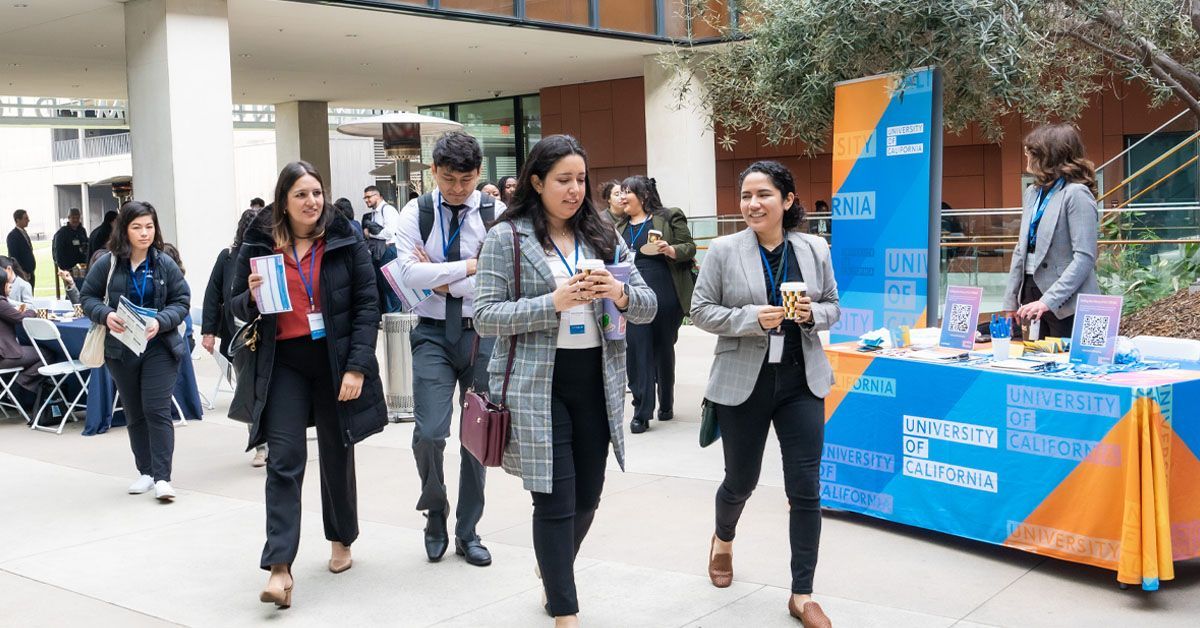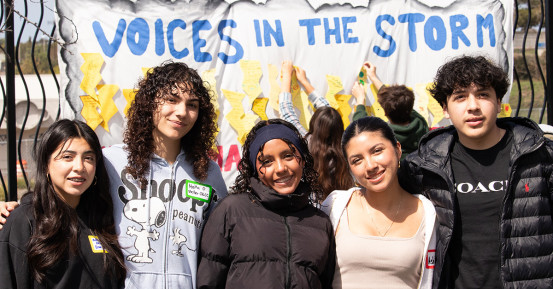The Right Care at the Right Time
UC San Diego School of Medicine Welcomes UC PRIME Programs to Campus
Story by:
Media contact:
Published Date
Story by:
Media contact:
Topics covered:
Share This:
Article Content
University of California San Diego School of Medicine recently welcomed nearly 200 students representing seven University of California campuses to the University of California Programs in Medical Education (PRIME) annual statewide UC PRIME Conference. This year’s theme, “The Right Care at the Right Time,” provided an opportunity to showcase the PRIME programs across the state and reflect on the program’s role in shaping the future of health care in California. This was the first time the PRIME programs gathered in person since 2020.
The UC PRIME programs were established to provide future physicians-leaders with specialized training to care for and advocate on behalf of communities who have not historically had regular access to high-quality health care. The first PRIME program launched at UC Irvine in 2004 and, two decades later, there are now 10 programs at the six UC medical schools across the state. Each program has a dedicated area of focus to include rural health care and telemedicine, urban underserved populations, and more. Upon completion of PRIME, students will graduate with a Doctor of Medicine (MD) degree from their home institution. Many will also earn a master’s degree from an institution of their choice in a specialty related to their PRIME area of focus.
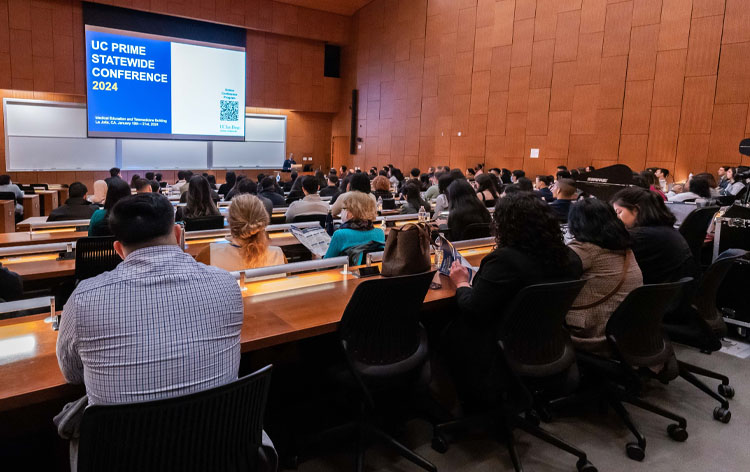
UC San Diego is home to two PRIME Programs – PRIME-Health Equity (PRIME-HEq), which aims to reduce health care delivery disparities, and PRIME-Transforming Indigenous Doctor Education (PRIME-TIDE), which prepares students for careers focused on providing health care to Indigenous populations.
“We believed that a PRIME program focused on health equity was critical, because health equity promotes fairness and social justice in health care, ensuring that everyone has an equal opportunity to attain good health,” explained Michelle Daniel, MD, vice dean for medical education at UC San Diego School of Medicine. “Achieving health equity leads to improved overall public health, economic productivity, and reduced health disparities. It is an ethical imperative that not only fosters social cohesion but also delivers long-term societal benefits by addressing systemic issues in health care access and outcomes.”
Fourth-year UC San Diego PRIME-HEq medical student, Chelsea Maduike, learned about PRIME as an undergraduate at UCLA. She recalls taking a class focused on maternal and child health care and seeing the social and health care disparities which impact these populations and thought to herself, why are we not fixing this?
“Coming from a family that experienced barriers and difficulty with accessing health care, that class and learning about PRIME made me want to learn more about how to address health disparities in the communities I serve,” said Maduike. “When applying to medical school, if a school had a PRIME program, I made sure I applied to it. I wanted to be part of this community, to do my part to combat what is happening in health care. PRIME has been so impactful in my life. It has encouraged me to have a voice. I want to be a leader to continue helping others and building community for all.”
UC San Diego’s PRIME-TIDE is the newest program among the UC PRIME programs. In its second academic year, PRIME-TIDE is one of two in the state focused on Indigenous health care. There are currently 10 students enrolled in PRIME-TIDE at UC San Diego.
PRIME has proven instrumental in supplying physicians to populations in need. Of the 114 PRIME graduates from UC San Diego, 55 percent of graduates have entered primary care specialties and 82 percent of these alumni are practicing at safety net institutions or medically underserved areas.
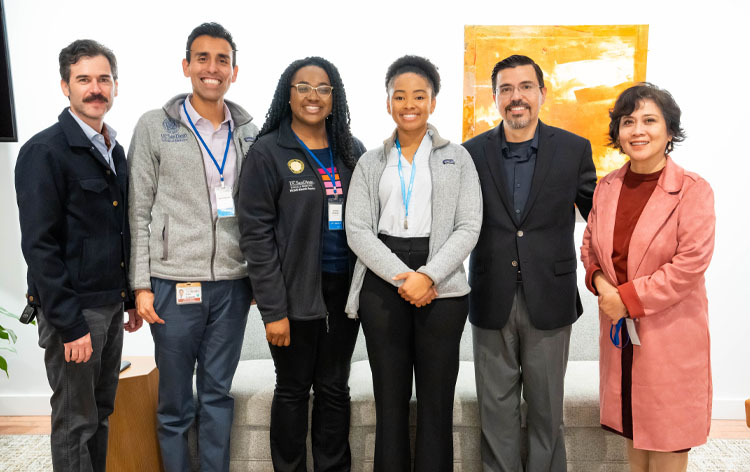
Pictured from left: Jacob Bailey, MD, MA, assistant director of PRIME-HEq; PRIME students Ivan Copado, Chelsea Maduike and Erin Buckner; Luis Castellanos, MD, MPH, director of PRIME-HEq; and Maria Rosario (Happy) Araneta, PhD, MPH, associate dean for diversity & community partnerships at UC San Diego School of Medicine.
“This is such a critical outcome and shows that when you embrace the importance of addressing health equity and health disparities as a medical student, you tend to do so in practice.” said Daniel. “Our PRIME programs are effectively addressing the critical shortage in primary care physicians in our state and nation.”
Aiming to reduce health disparities experienced by our most vulnerable communities, the UC PRIME program encourages students from underserved communities to pursue careers in medicine. UC PRIME programs have significantly increased the racial and ethnic diversity across the UC medical education system. Across the state, 74 percent of PRIME students are from groups underrepresented in medicine.
“Having a diverse group of medical students who have personal connections to underserved communities can be instrumental in addressing health disparities, which is a key goal of these programs,” Daniel said. “Diverse students are also more likely to choose to practice in underserved areas and provide health care where it is needed most.”
Reflecting on health care in California
The PRIME students are committed to changing the future of health care. Throughout the conference, attendees chose from a variety of sessions focusing on different aspects of health disparity, overcoming region specific challenges and building and empowering others to continue the PRIME mission.
Fourth-year UC San Diego medical student Ivan Copado spoke about how to build a pathway to medical diversity. His personal experience as the child of immigrants inspired his commitment to pursuing a career in ophthalmology. He shared that when his uncle came to the United States, his uncle was unable to get care for Type 1 diabetes due to his immigration status. Ultimately, Copado’s uncle lost his vision due to the inability to receive care.
“My uncle’s story really impacted me and followed me throughout medical school,” said Copado. “PRIME-Health Equity has been one of the most important components of my time at UC San Diego. I was able to work with people who are like-minded, who taught me so much about different cultures, different backgrounds and that enabled me to really see and approach my patients in different ways. I want to be that provider who can see the world through the perspective of a patient while considering their respective cultural identities.”
Looking beyond today
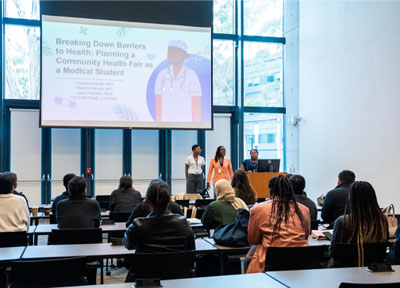
According to Jacob Bailey, MD, MA, assistant director of PRIME-HEq and assistant professor in the Department of Medicine at UC San Diego School of Medicine, one of the key outcomes of the annual statewide UC PRIME conference is the community building which takes place among the students.
“We know PRIME programming helps center and fortify students' professional identity to serve underserved and vulnerable communities,” said Bailey. “All of the conference's activities revolve around supporting them in this mission, expanding their peer network, and creating their professional community. By bringing these like-minded students together to have discussions, form relationships and create community, we are building for a better tomorrow.”
You May Also Like
Stay in the Know
Keep up with all the latest from UC San Diego. Subscribe to the newsletter today.
